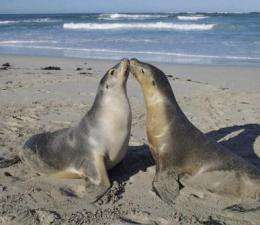March 2, 2016 report
Researchers find compelling evidence linking dying California sea lion pups with change in mothers' diet

A team of researchers with NOAA Fisheries Service's Southwest Fisheries Science Center has found "compelling evidence" in the search for the reason behind record numbers of starving sea lion pups climbing out of the sea and onto California beaches. In their paper published in Royal Society Open Science, the team describes how their study of fish populations and hunting activities of pregnant sea lions off the coast of California, led to evidence that suggests the pups are starving because the main food source for their mothers has become scarcer.
Starving or very hungry sea lion pups have been seen on California shores before, typically during El Niño,events, but this year the numbers have been much higher than usual, attracting the attention of beachcombers and environmentalists alike. To find out why, the researchers with this new effort started by looking for data on pregnant sea lion hunting grounds—six such females were tracked allowing researchers to see that they typically hunted between Malibu and Big Sur. The next logical step was to look at what the mothers were eating in those locations. To find out, the team looked at looked at fish census data that had been taken for the area during the time period 2004 till 2014. They also looked at the average weight of sea lion pups tested on San Miguel Island during the years 2004 till 2011.
Finally, the team looked at all the data they had collected searching for a pattern. They report that the evidence was clear, during the years that high fat sardines and anchovies were in high abundance, pup weight was normal. That was not the case, however, when sardines and anchovies were scarce, forcing pregnant mothers to switch to eating much lower in fat rockfish and market squid—pup weight dropped dramatically. The pups are starving, the team reports, because their mothers cannot produce enough milk for them on such a low-fat diet.
The problem has come about, they note, because of human activities. Conservation efforts over the past half century have led to a resurgence in sea lion populations, while over the same time period, humans have found a growing hunger for both anchovies and sardines, leaving their populations shrinking.
More information: Sam McClatchie et al., Food limitation of sea lion pups and the decline of forage off central and southern California, Royal Society Open Science (2016). DOI: 10.1098/rsos.150628
Journal information: Royal Society Open Science
© 2016 Phys.org


















